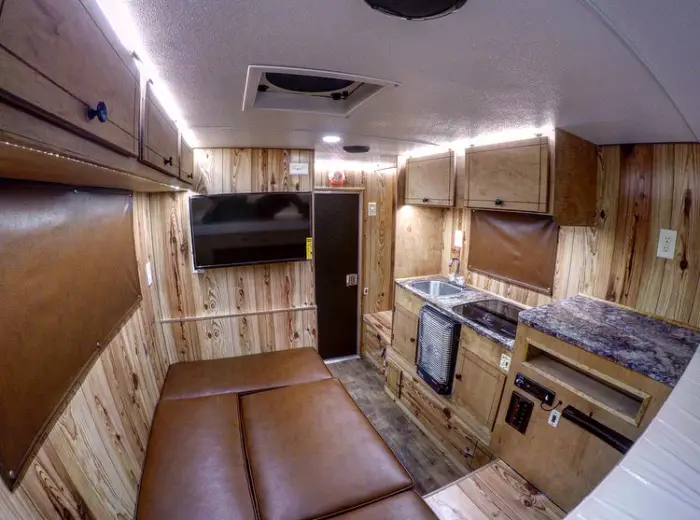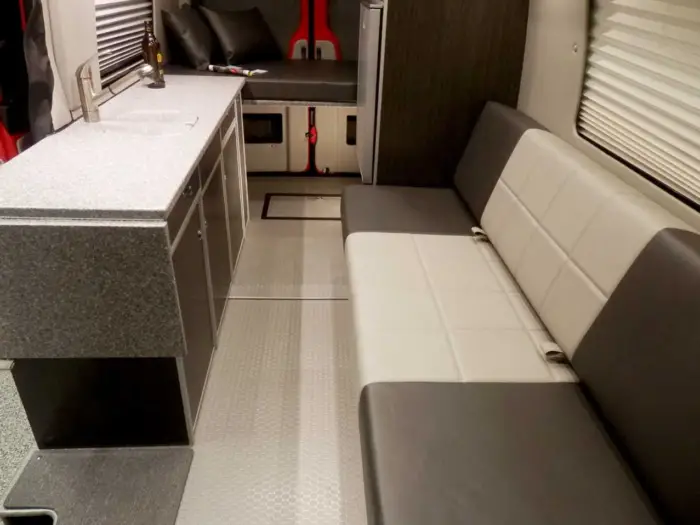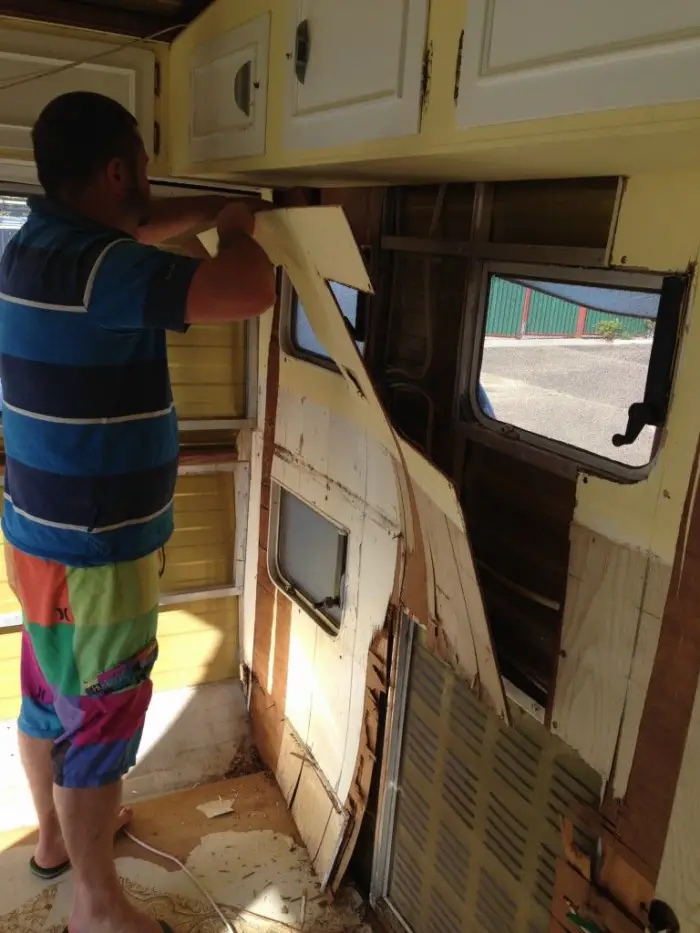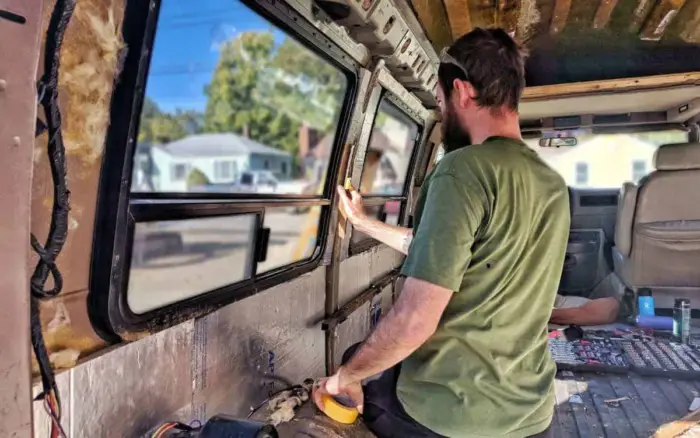It’s quite easy to repair travel trailer interior walls when you know exactly what the problem is, and to what extent the interior damage is.
The major cause of the interior wall damage is water.
A precise knowledge of the materials used in making the travel trailers campers will help you to know the degree of the damage and how to fix it.
According to research by Savvy Camper, the average life of a travel trailer is 12 years, but it can reach 25 years with proper maintenance.
The main item to keep watch for is water damage from the roof or sides. Sealing these every six months will keep your trailer lasting a long time.

The duration of your travel trailer depends on how often you maintain it. The minimum lifespan of travel trailers is between 9 years to 25 years, according to Savvy Camper.
There are two main types of materials used in the production of both interior and exterior walls of travel trailer campers. They include:
- Fiberglass material
- Aluminum material
Let us study the causes of these interior wall damages based on the materials stated above.
Fiberglass material
The picture below shows the interior image of a travel trailer made with fiberglass material.

First, let’s start with campers made with fiberglass. The interior wall of an RV camper made with fiberglass can easily get damaged as a result of water and ultraviolet heat.
How does water affect the interior walls of campers made with Fiberglass materials? Read on to know-how.
The interior walls of travel trailers get damaged when water enters inside of the walls as a result of exterior leakage due to the delamination of the fiberglass after being exposed to heat or by accident.
Most of the time, what causes this delamination is a result of heat when it’s exposed to hot weather for a very long time without being packed under shade.
Likewise, when the edges that were laminated start to lose their glues, this causes an opening for easy flow of water, which brings about the destruction of the interior walls.
Fiberglass campers are built for water to run from the outside, not the inside, but running this water, sometimes, can lead to the peeling of the panels.
Also, once the glues that hold the fiberglass together with the Lauan wood lose their cello strength, then, delamination occurs — from there, water penetrates through the walls, which leads to interior wall damage.
Another factor that could damage the interior wall of a fiberglass camper is scratch. Due to the smoothness of the fiberglass campers, a mild scratch can be easily noticeable, and from there, major damages occur.
Fiberglass travel trailer campers have front or rear, which are not vacuum but are joined together or glued. Immediately water gets to any of these parts, especially the window side. It gets the cardboard wet, and once it’s wet, it destroys the interior walls.
Aluminum material
The image below shows a travel trailer made up of aluminum materials.

How does water affect the interior walls of campers made with Aluminum materials? Read on to find out.
When the silicone on the sides or roof corners of travel campers made with aluminum materials isn’t properly sealed, it develops a leakage, by which water flows through to damage the interior walls.
The water that flows inside the walls might cause serious damage. Most time, it takes time to discover it; by then, it has damaged the interior wall.
You might be wondering where the water passes. It flows through the hollow that is in the camper. These hollows are peculiar to RV campers that are made up of aluminum materials.
Meanwhile, the rust causes the battery to fall down most times and creates openings in the walls that are practically not good for the campers.
Apart from travel trailer campers, having accidents, water also destroys the travel trailer interior wall.
Now that you have an idea of the causes of the camper’s damage and the extent of the damage, you can begin to figure out the solution to the problem.
The precaution for this interior wall damage is shown below:
- Not to expose the travel trailer campers to any of the factors that could damage it easily, and
- Repair the already damaged parts.
In this article, I will show you steps on how to repair the interior wall of travel trailer campers.
These steps apply to both the Fiberglass campers RV and the Aluminum campers RV.
Here are five steps on how to repair the travel trailer interior wall.
Step 1: Remove The Old Siding

Are you ready to fix the interior parts of your camper’s recreational vehicle by yourself? Then, let’s get started.
The interior of the travel trailer campers has already been framed. Therefore you don’t have to bother yourself with it. All you need is to know the extent of the damage.
When you have found out the level of the damages, then you can budget for the cost. (Budget here simply means the money you will spend to buy materials even though you will build it by yourself).
This exercise will save you some expenses during repairs. Make sure you carry out a thorough check on the interior to know the level of damage before you start.
Since you have studied the degree of the damage, let’s start by removing the interior cover. This will let you know and see the rust areas.
Get to work now.
Take away any obstacle that may obstruct you from accessing the wall properly. Below are the things that might likely cause an obstruction when accessing the wall:
- Cabinets
- Curtain rails
- Furnishings
- Sticker-on tiles
- Wallpaper
Remove or peel away anything that may complicate issues during this assessment to enable you to do clean work. Take away the liquid nails and the expansion foam from the frame.
Probably you may come across some electrical wires and pipes buried in the section of the wall you want to repair. So, remove everything for another re-fixing and re-wiring.
Step 2: Maintain The Existing Wall (Frame)
Don’t destroy the existing frame. Probably the exterior may be good. Focus on the interior.
Leave the frame the way it is and quietly remove the board that was glued or stapled with the frame.
Re-frame some parts that might have rusted with new wood — to make it strong but don’t destroy the entire frame if there’s no need for it.
Step 3: Start Re-Building The Interior
At this point, you’re done with removing the panel, plywood, electrical wires, plumbing pipes, and the foam with other things like stapled areas.
The next thing is to apply an RV Leak seal rust inhibitor (e.g., Rust-Oleum) after you might have fully scraped the entire rusted place and put new materials.
You might use two or three coats of it or more depend on the size of your trailer.
Allow it to dry for 24 hours.
Once you’re done, apply liquid nail, a synthetic rubber multi-use adhesive that is solvent-based, which has a lasting bold to most substrates.

Fix the insulation boards to their proper position before you proceed. Ensure they’re properly placed as they were before.
Carefully insulate the wall to avoid bad work. Make the work neat and nice. Try to position them properly before you proceed to the next level of interior wall repairs.
Step 4: Apply The Expansion Foam
You’re almost done with the interior wall. So, before you apply the expansion foam, make sure you’re through with all your electrical wiring and plumbing.
After this, it simply means you’re ready to apply the expansion form. So go ahead to apply the expansion forms and cement everything to the wall. Make sure all the gaps are properly filled carefully.
Trim off the excess foam. You may use a little saw or any other sharp object to spread the foam as well.
Step 5: Get Done With The Interior Wall Repair
At this point, you’re at the final stage of repairing the interior of your travel trailer.
Get your plywood and panel ready. Take a measurement of the side of the plywood and cut it out.
Place the plywood on a construction table and cut the exact measure, so that you can get the edges. You might use Jigsaw to cut the panel or any other sharp object that could give you the precise measure.
Screw in the curtain rod’s holders properly and put them in the place where they are supposed to be. Ensure the plywood and the curtain rod are well placed so that you will not have to begin the exercise again.
Make sure you have removed the insulation block by using a flat bar. The flat bar will enable you to do the work perfectly well.
Check for any rust, and remove all that you can see. Get rid of the big flakes and smooth everything out as possible.
Now you can apply liquid nails for proper closure. Put back the insulation block to the exact place.
Don’t use a hammer at this stage because this will make the interior not smooth. Place the paneling properly and well into its place.
Fill the entire gap and wipe after you are done with the filling. Apply color putty and cover the area that needs to be covered.
At this point, you can start to put tiles, and wallpaper, furnish the interior, and plumb the entire kitchen, toilet, and every other part that requires such.
Now your trailer interior has taken up a new shape. It has a good look and is conducive to family camping.
Conclusion
We came to the end on how to repair travel trailer campers. By now, you shouldn’t be confused.
Take the steps one after the other to fix the interior walls of your camper. Firstly, get to know what types of material your RV is made up of.
Secondly, ascertain the level of interior damage. Get the necessary material ready
Get to work, and follow the steps the way it’s outlined in this article.
At any point, if you are confused, come back to read the article to understand the next step to take.
When you understand this article and the points pointed out here, your trailer’s interior will get a new shape and a good look.
